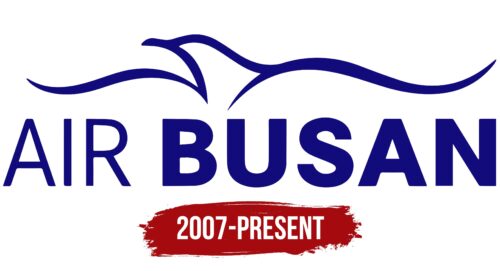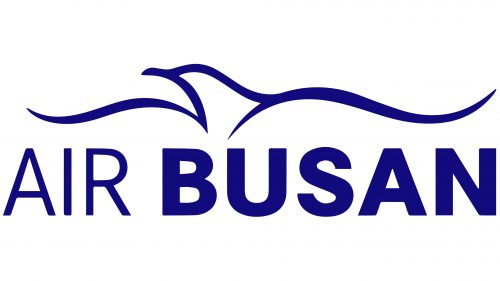The Air Busan logo is a symbolic compass pointing travelers to the limitless sky. It serves as a visual affirmation of the airline’s commitment to providing service and unforgettable experiences. The emblem represents the freedom and vastness of air travel, conveying the essence of traveling across borders.
Air Busan: Brand overview
Air Busan was established in Busan, South Korea, on August 31, 2007. This airline was a collaborative effort involving Busan’s city administration, Asiana Airlines, and Busa-Petroleum Investment. The aim was to establish an affordable airline to improve connections from Busan to other parts of Korea and nearby international destinations and develop Busan into a key hub for aviation in East Asia.
Air Busan launched its first flight on October 25, 2008, flying a Boeing 737-400 from Busan to Jeju. This marked the beginning of its services, initially connecting major South Korean cities such as Seoul, Jeju, Muan, and Daegu. These routes helped to enhance national connectivity and supported tourism and business within the country.
In 2010, Air Busan began international services with flights to Osaka and Sapporo, focusing on destinations that shared cultural and economic ties with South Korea. Throughout the decade, the airline expanded by adding modern Boeing 737-800s and Airbus A321s to its fleet, which grew to 30 aircraft by 2019.
The airline expanded its network to include new destinations across the Asia-Pacific region, such as Hong Kong, Macau, Taiwan, Guam, and Palau. These routes facilitated cultural exchanges and economic opportunities, appealing to tourists and business travelers.
Today, Air Busan is recognized as one of the leading budget airlines in South Korea. It offers over 40 domestic and international routes and operates over 150 flights daily, serving approximately 10 million passengers annually. The fleet comprises 32 narrow-body aircraft, including Boeing 737 and Airbus A321. Air Busan’s main operations are based out of Gimhae International Airport in Busan, with additional significant operations in Seoul, Jeju, and other key South Korean cities.
Since its inception in 2007, Air Busan has evolved from a small regional carrier into a significant player in the budget aviation market. It continuously works to expand its services and enhance the travel experience while maintaining strong ties to its origins and extending its reach globally.
Meaning and History
What is Air Busan?
It is a major player in the South Korean aviation market. Headquartered in Busanjingu, Busan, South Korea, this low-cost airline has opened the skies to a wider audience, allowing them to experience the world. The airline gradually expanded its presence to international destinations, starting with domestic flights. Today, the airline serves a wide network of routes, successfully meeting the needs of both domestic and international passengers.
2007 – today
Air Busan’s logo features a bird flying forward with its wings spread wide, symbolizing the airline’s readiness to brave any distance. The logo’s centerpiece is a bird capable of flying high and far. Below the wings, the company name appears in two different fonts. The first segment uses narrow letters, while the second uses wider ones. The designers created this contrast by combining bold and thin glyphs, opting for sans-serif variants to indicate that both words are part of a whole. The emblem is colored blue.
Blue evokes feelings of depth, sky, and reliability. The contrasting fonts give the emblem a dynamic feel, reinforcing the sense of movement embodied by the bird. The choice of the bird as the central element resonates with the aviation theme, emphasizing freedom, attainability, and aspiration.
With its wings spread wide, the bird conveys a sense of motion and adventure. The company name’s narrow and wide letters add a unique visual rhythm to the logo. The sans-serif fonts provide a modern, clean look, enhancing the overall aesthetic.
The blue color represents the sky and symbolizes trust and dependability. The combination of bold and thin glyphs in the fonts creates a visually appealing contrast, making the logo stand out. This thoughtful design effectively captures the essence of Air Busan’s mission and values.
FAQ
Is Air Busan a budget airline?
Yes, Air Busan is a budget airline. Established in 2007 in Busanjin-gu, Busan, South Korea, it operates as a low-cost carrier. Air Busan offers air travel at lower prices than full-service airlines. They manage to keep prices low by using a simpler operational model, which includes flying to less busy airports and providing fewer in-flight services. Air Busan aims to make flying affordable for more people, focusing on domestic routes within South Korea and nearby international flights. This approach helps them serve customers, including tourists and business travelers looking for cost-effective travel solutions.
What is the personal item on Air Busan?
Air Busan allows you to bring a few personal items on board in addition to your regular carry-on bag, which should weigh no more than 10kg and be small enough to fit within 115cm in total dimensions. Here are the personal items you can take with you:
- Handbag or Purse: You can bring a small handbag or purse. This is useful for keeping items like your wallet and keys close by. Make sure it’s small enough to fit under the seat in front of you.
- Coat or Jacket: Feel free to carry a coat or jacket, which can be handy for changing weather conditions at your destination or inside the cabin.
- Umbrella: A compact, foldable umbrella is allowed on board. This is helpful if traveling to or from where it might rain.
- Reading Material: Bring books, magazines, or an e-reader. These are perfect for staying entertained during your flight.
These items should fit comfortably under the seat before you or in the overhead bin. This policy ensures you have everything you need during your flight without overcrowding the cabin.
Who owns Busan Air?
Asiana Airlines is the primary owner of Air Busan, holding 41.9% of the airline. This significant stake makes Asiana the main shareholder and gives it a substantial role in guiding Air Busan’s operations and strategic decisions.
Various stakeholders, including the city of Busan and several local businesses, hold the rest of Air Busan’s 16.11% shares. This mix of owners reflects the airline’s key role in South Korea’s aviation market and its importance to the regional economy. The involvement of the city of Busan and other local entities shows their support for regional development and improved connectivity for both people and businesses.
What airlines are affiliated with Air Busan?
Air Busan is a subsidiary of Asiana Airlines and operates under its guidance. This connection gives Air Busan access to Asiana’s extensive network and resources, improving its operations and services. The airline coordinates flights and shares services with Asiana, making it more efficient.
Air Busan’s main base is at Gimhae International Airport. This airport is crucial for both domestic and international flights. It makes transferring between Air Busan and Asiana Airlines smooth for passengers. This strategic placement helps Air Busan connect to many destinations effectively and strengthens its position in the market by using Asiana’s established reputation.





